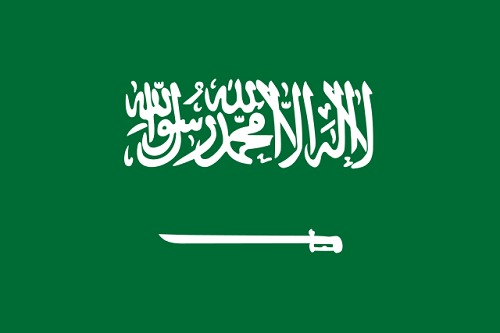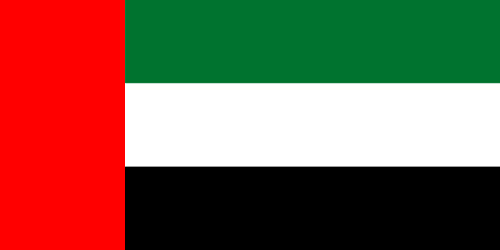Difference between Saudi Arabia and UAE

Saudi Arabia Flag
Saudi Arabia and United Arab Emirates (UAE) are the two major economies of the Middle East. Both countries are parts to the Gulf Cooperation Council (GCC) – an economic and political alliance established in Riyadh in 1981 among six Middle Eastern countries: Bahrain, Kuwait, Oman, Qatar, Saudi Arabia, and United Arab Emirates. GCC’s aim is the achievement of common goals and the promotion of common identities and unity – based on the principles of Islamic beliefs. However, despite their similar economic systems, their role in the region, their membership in the GCC, and their similar geographic features, the two countries differ on several aspects.
Saudi Arabia
Capital: Riyad
Area: 2,149,690 sq km
Population: 28,160,273 (as of June 2016)
Religion: Islam
Official language: Arabic
Currency: Saudi Riyal
Modern Saudi Arabia was created in 1932 by king Abdul Aziz bin Abdul Rahman Al Saud (Ibn Saud) – who organized the kingdom in a modern way and based his reign on the principles of the Islamic faith. King Abdulaziz died in 1953 and, today, Saudi Arabia is led by one of his (male) heirs: Salmān bin ʿAbd al-ʿAzīz Āl Saʿūd, who took power in 2015.
Since its creation, the kingdom of Saudi Arabia has been largely involved in the geo-political and economic matters of the region:
- In 1960, Saudi Arabia became a founding member of OPEC (Organization of Petroleum Exporting Countries);
- In 1970, Saudi Arabia was involved in the creation of OIC (Organization of the Islamic Conference);
- In 1973, Saudi Arabia led an oil boycott against the Western countries that were siding Israel during the so-called October war fought against Syria and Egypt;
- In 1981, Saudi Arabia participated in the creation of the GCC (Gulf Cooperation Council);
- In 1990, Saudi Arabia condemned Iraq’s invasion of Kuwait and expelled citizens of Jordan and Yemen from the country because their government supported Iraq;
- In 1991, Saudi Arabia attacked Iraq attempting to liberate Kuwait;
- In 1996, relations with the United States began to deteriorate when a bomb exploded at the US military complex in Dhahran;
- In 2011, 15 of the 19 attackers of the 9/11 were believed to be Saudi nationals;
- In 2014, a new anti-terrorism law was introduced;
- In 2015, women participated in municipal elections for the first time;
- In 2016, the United Nations and the international community accused Saudi Arabia of fighting the al-Houthi militias in Yemen with indiscriminate airstrikes that overly affected civilians; and
- In 2017, Saudi Arabia initiated a land, air and sea blockade against Qatar to push the country to cut its connections with terrorist organizations.
To date, Saudi Arabia continues to play an important role in the region. In fact, in addition to its political influence and its military power, Saudi Arabia has a strong economic leverage on its neighbors. The country has an oil-based economy; it is considered the largest exporter of petroleum in the world; and it owns around 16% of the global petroleum reserves. Petroleum is the core of Saudi’s economy and accounts for about 87% of all budget revenues (and 90% of export earnings).
Moreover, the king is implementing different policies to modernize and diversify the country’s economy, including:
- Encouraging private investments and the growth of the private sector;
- Reducing unemployment;
- Focusing on youth employment;
- Fostering privatization of health care and education; and
- Investing in the tourism industry.

UAE Flag
United Arab Emirates
Capital: Abu Dhabi
Area: 83,600 sq km
Population: 5,927,48 (as of June 2016)
Religion: Islam
Official language: Arabic
Currency: UAE Dirham
After gaining independence from Britain, six states – Abu Dhabi, ‘Ajman, Al Fujayrah, Ash Shariqah, Dubayy, and Umm al Qaywayn – merged to form the United Arab Emirates in 1971. In 1972, they were joined by the seventh state: Ra’s al Khaymah. Since then, the importance of UAE in the region grew exponentially.
- In 1981, UAE became one of the funding members of the GCC – the first meeting was held in Abu Dhabi;
- In 1991, UAE joined the offensive against Iraq after the invasion of Kuwait;
- In 1998, UAE restored diplomatic ties with Iraq;
- In 2006, UAE implemented important economic reforms to conform to Western standards and to promote employment for locals;
- In 2006, UAE held first ever national elections;
- In 2008, UAE entirely cancelled Iraq’s debit (around $7 billion);
- In 2009, UAE withdrew from plans of creating a Gulf monetary union;
- In 2010, the tallest man-made building in the world – the astonishing Burj Khalifa tower – opened in Dubai;
- In 2012, UAE harshened measures against dissidents and activists – since then, over 60 activists were detained without charges;
- In 2014, UAE intervened with airstrikes in Libya and Syria;
- In 2015, UAE conducted airstrikes in Yemen;
- In 2017, UAE closed an agreement with Somaliland for the creation of a military base in the area.
As most Arab countries, United Arab Emirates has an oil-based economy. However, attempts to diversify the economic system have reduced to only 30% the portion of GDP accounted for by oil and gas. UAE’s strength lies in its “free trade zones” where foreign (and local) investors pay zero taxes. Trying to minimize the challenges posed by the economic crisis and low oil prices, UAE is diversifying the economy by:
- Fostering infrastructure expansion;
- Encouraging privatization;
- Creating favorable conditions for foreign investors;
- Introducing Value Added Taxes (tentatively by January 2018);
- Promoting tourism;
- Developing industries;
- Creating job opportunities for locals; and
- Increasing employment in the private sector.
Saudi Arabia vs UAE: women’s rights
Besides natural historical differences, Saudi Arabia and United Arab Emirates differ on several other levels. For instance, while Saudi Arabia strictly enforces the rules and principles of the Islamic faith in almost all aspects of public life, UAE has a more open society – in particular in the international, ultra-dynamic Dubai and Abu Dhabi. Such tendency is evident in the different ways in which women are treated in the two countries. In fact, due to the strong attachment to the principles of Islam and to the values of a historically patriarchal society, in Saudi Arabia women have limited rights. For instance:
- Women cannot drive cars. In Saudi’s view, allowing women to drive would dangerously undermine “social values;”
- Women cannot wear what they want. Although they are not always (and not everywhere) obliged to wear a burka, women have to refrain from “showing off” their beauty and their body;
- Women cannot spend time (or are allowed very limited contacts) with men they are not related to;
- Women cannot compete freely in sport; and
- Women cannot travel without “male guardianship” – although recent protests are pushing for the amendment of such provision.
Conversely, the United Arab Emirates is known for being at the forefront of women empowerment in the region. In fact, in the country, women can drive and wear (almost) whatever they want; furthermore, they have a higher degree of personal freedom if compared to Saudi Arabia. However, even in UAE, women face various types of discrimination and marginalization. According to a shadow report submitted by FIDH (International Federation for Human Rights) to the CEDAW (Committee for the Elimination of Discrimination Against Women), the main issues related to women’s rights in UAE are, inter alia:
- Absence of prohibition or punishment of gender-based discrimination;
- Discrimination in the job market and in the education system;
- Lack of protection against violence and rape; and
- Restriction of personal and collective freedoms.
Summary
Saudi Arabia and United Arab Emirates are two Muslim countries and the two main economic powers of the Arab region. Both countries have oil-based economies – although Saudi Arabia is the largest exporter of petroleum in the world while UAE is trying to reduce its dependency on oil exports – and both are important economic partners of Western countries.
Saudi Arabia has a stronger influence in the region compared to UAE but both countries are part of several international and regional organizations, including IMF, ILO, GCC, OIC, OPCW, OPEC, PCA, UN, UNCTAD, UNESCO, UNIDO, UNRWA, UNWTO, UPU, WHO, WIPO, and WTO.
However, despite their economic ties, their proximity and their similarities, Saudi Arabia and UAE differ on several aspects:
- Saudi Arabia obtained independence in 1932 whereas UAE unified in 1971;
- Saudi Arabia is an absolute monarchy whereas UAE is a federation of 7 monarchies;
- Saudi Arabia is a more conservative country based on Islamic law (Sharia) whereas UAE is a more modern country whose legal system is a mix of Islamic and civil law;
- In Saudi Arabia, women have very limited rights – they cannot drive or dress however they want – whereas UAE’s attitude towards women and women’s rights is more liberal;
- UAE has taxes free zones that attract foreign investors whereas Saudi Arabia does not;
- Saudi Arabia faced protests during the 2010 Arab Spring while UAE avoided insurrections by increasing investments in the poorer areas of the country; and
- Both countries have modern cities (i.e. Jeddah in Saudi Arabia and Dubai in UAE) but UAE is way ahead Saudi Arabia when it comes to being modern and progressive.
- Difference Between Michelle Obama and Melania - January 29, 2019
- Difference Between Trump and Modi - December 4, 2018
- Difference Between Carbon Tax And Cap And Trade - December 4, 2018
Search DifferenceBetween.net :
1 Comment
Leave a Response
References :
[0]10 Noticeable Differences between Saudi Arabia and United Arab Emirates, available at https://www.outlookpakistan.com/10-noticable-difference-united-arab-emirates-saudi-arab/9660/
[1]Compare Saudi Arabia to United Arab Emirates, If it were my home, available at http://www.ifitweremyhome.com/compare/SA/AE
[2]FACTBOX-Rivalry and differences between Saudi and UAE, Reuters, available at http://www.reuters.com/article/gulf-union-idUSLDE63405T20100406
[3]Gulf Cooperation Countries, Encyclopaedia Britannica, available at https://www.britannica.com/topic/Gulf-Cooperation-Council
[4]King Abdul Aziz bin Abdul Rahman Al Saud (Ibn Saud), Ministry of Foreign Affairs Saudi Arabia, available at http://www.mofa.gov.sa/sites/mofaen/ServicesAndInformation/aboutKingDom/SaudiArabiaKings/Pages/KingAbulAziz.aspx
[5]Saudi Arabia profile – Timeline, BBC News, available at http://www.bbc.com/news/world-middle-east-14703523
[6]Saudi Arabia vs. United Arab Emirates, Index Mundi, available at http://www.indexmundi.com/factbook/compare/saudi-arabia.united-arab-emirates
[7]Seven things women in Saudi Arabia cannot do, The Week, available at http://www.theweek.co.uk/60339/nine-things-women-cant-do-in-saudi-arabia
[8]United Arab Emirates profile – Timeline, BBC News, available at http://www.bbc.com/news/world-middle-east-14704414
[9]Women's Rights in the United Arab Emirates (UAE), Report of the FIDH to the CEDAW, available at https://www.fidh.org/IMG/pdf/UAE_summaryreport_for_CEDAW.pdf
[10]https://commons.wikimedia.org/wiki/File:Flag_of_Saudi_Arabia.svg
[11]https://en.wikipedia.org/wiki/Flag_of_the_United_Arab_Emirates

The Middle East Is an interesting Poodle in the short term.
The UAE sounds like a modern Nation that gives people a Choice to exhibit their talent and freedom.
With time it is obvious that Saudi Arabia will have to become a Kind of UAE.
However the Islam of Wahabism of the Saudis is matter of reforming Islam and to mix and enable people to be free.
The Koran has been taken out of context in matters of so many issues.
No one knows if Mohammed Really lived or existed.
This debate about Religious existence and the influx of Politics us the Reason why Islam has a complex Problem within our History.
Allah wants people of every Ethnic Group to come together and be one,
The Concept of God is OK but then we need to understand certain matters.